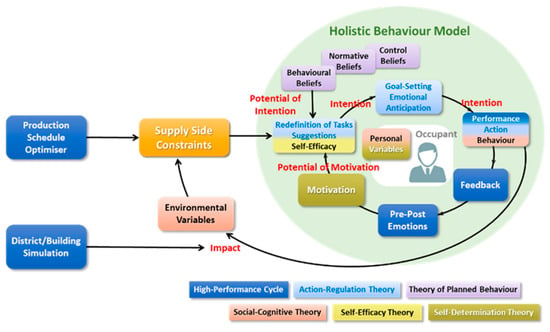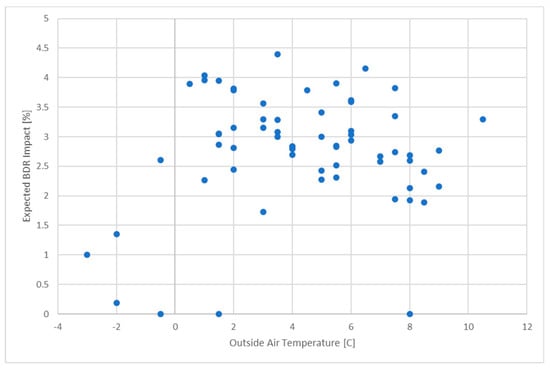Abstract
Behaviour Demand Response (BDR) is an approach that enables the adaptation of operation of the district heating assets to dynamic market and capacity constraints by asking building occupants to participate and temporarily alter their demand profiles. In this paper we will present an explicit behavioural occupant model that considers motivational factors beyond financial incentives and that integrates with the district heating simulation model of the CIT Bishopstown campus, which has been used as a testbed for the E2District project. Both models have been calibrated to reflect the actual occupant population and energy consumption of the campus for the 2018/2019 heating period. This allows an accurate simulation-based assessment of potential energy savings through different dynamic behaviour demand response (BDR) triggers. We will show how a generic district simulation model can be integrated with the occupant behaviour model to quantify the potential additional energy savings that can be achieved through better demand-side management of the heating system.
1. Introduction
The operation of district heating networks has traditionally focused on centrally controlled production, storage, and distribution assets. Pro-active optimisation of production and storage schedules based on predicted market and demand profiles in conjunction with re-active optimisation of asset control strategies based on heat demand is used to minimise overall energy consumption. A third factor promising to deliver additional energy savings is adapting demand profiles to market and capacity constraints. Such demand response strategies require the active participation of building occupants to adapt their behaviour accordingly. Comfort preferences and desire to keep in control of the environment outweigh by far the monetary incentives available to the individual occupant, therefore neither externally automated temperature control nor direct participation in the energy market seem to be viable routes towards demand response in many district heating scenarios. This is particularly true for public or workplace buildings, where the occupants have no direct financial stake in the energy consumption and therefore cannot be integrated as just another market participant in any optimisation strategy. In this paper we will present an explicit behavioural occupant model that considers motivational factors beyond financial incentives and that integrates with the district heating simulation model of the CIT Bishopstown campus, which has been used as a testbed for the E2District project. Both models have been calibrated to reflect the actual occupant population and energy consumption of the campus for the 2018/2019 heating period. This allows an accurate simulation-based assessment of potential energy savings through different dynamic behaviour demand response (BDR) triggers. We will show how a generic district simulation model can be integrated with the occupant behaviour model to derive a detailed mathematical formulation, that enables rigorous optimisation of such BDR triggers and to quantify the resulting energy savings. Applying this model to the data collected at the CIT Bishopstown campus during the heating season 2018/2019 we will show the potential additional energy savings that are achievable through better demand-side management of the heating system by applying optimised BDR triggers.
2. Model-Based BDR Optimisation
2.1. Occupant Behaviour Model
Modelling behaviour is a well-established field and many theories have been developed over the years [1]. The approach used here is based on a subset of well-stablished behavioural theories, such as the action-regulation-theory [2], the high-performance-cycle [3], the theory of planned behaviour [4], the self-determination theory [5], and the social cognitive theory [6] translated into an integrated probabilistic model of behaviour [7] enabling the sampling, and therefore probabilistic prediction, of identified behaviour relevant parameters (see Figure 1).

Figure 1.
The occupant behaviour model describing how the potential of intention can be assessed.
This model provides us with the tools and inventories to derive the potential of intention which is the probability that an occupant will act on a BDR trigger sent [8]. In the following we will discuss how this can be combined with a generic building/network model to derive the expected BDR impact.
2.2. Building/Network Model
In this section we will briefly outline how a generic building/network simulation model can be used to optimise the behaviour demand response actions to be triggered. Let there be a building/network model which takes as input the zone/circuit air temperature set-point schedules for zones/circuits each containing values for discrete time-steps. The model can take more inputs and generate more outputs as required, but as a minimum it should produce as output the achieved zone/circuit mean air temperatures as well as the energy schedules that need to be delivered to the building/network for each of the time-steps. This generic description of a building/network model will be used in the following to assess the potential impact of demand-response actions on the overall energy performance. Note, that any model capable of processing this input/output pattern can be used for the presented approach.
To link the model with demand-response actions, we define such potential actions that can be executed by building occupants and that can be triggered by sending a message to the right individual within the building. Furthermore, let there be context zones with each context zone having associated a set of actions . Let each context zone be associated with a heating circuit in the building/network model to affect a given relative area of that circuit. Furthermore, each action is associated with a lifetime , being the time interval the action is applied for, and a temperature set-point , being the value the set-point is changed to during this time interval.
The impact of any action executed at time can then be assessed using the building/network model by applying the following procedure:
- Alter the zone/circuit air temperature set-points in the model such that and compute the resulting mean air temperatures to assess the thermal behaviour of relevant overall circuits/zones
- Estimate or measure the actual temperatures of the affected context areas and compare them to the computed expected mean air temperatures resulting from the building/network model. Taking into consideration the relative size of the context area, re-run the simulation with mean air temperature set-points set to to obtain the energy required by the building/network assuming the demand-response action has been taken.
- We can apply any function to account for varying energy prices on dynamic markets where required so the resulting impact is now given by .
2.3. Linking the Occupant Behaviour Model with the Building/Network Model
Having outlined the building/network model we will now outline how a behavioural model can be linked to the physical model in order to derive a formulation that allows for optimising behaviour demand response triggers. To achieve this let all of the demand response actions be elements of not necessarily disjoint exclusivity sets with representing actions that cannot occur together. This mechanism is used to exclude mutually exclusive actions, such as adapting the same thermostatic set-point to two different settings. Furthermore, each action is not only associated with a lifetime , being the time interval the action is applied, but also a refractory period , being the time interval after triggering the action for which this action cannot be triggered again. This mechanism is used to prevent triggering demand-response events to frequently in the same area and to achieve a better sharing of responsibility across the space. We also introduce a Boolean feasibility function for determining if action is feasible to be triggered at time . We use this mechanism to prevent requiring the reduction of room thermostat set-points below acceptable comfort limits.
Now let there be participants . Similar to the feasibility function we introduce a Boolean context function denoting if a participant is present in context zone at time . We use a smart-phone based presence detection and prediction system in the rooms to determine if a space is occupied. Finally, let the intention to act on an action be denoted as . This quantity is calculated using the behavioural model outlined in Section 2.1 above.
Finally, we introduce the trigger message matrix with the element denoting that participant is asked to perform action at time or if no action is requested. A valid trigger message matrix has to satisfy all of the following constraints:
- Exclusivity:
- Refractory period:
- Feasibility:
- Presence:
The goal is now to determine a valid trigger message matrix with the highest expected impact. To achieve this efficiently we have to devise some heuristics how to generate reasonable message trigger matrices. Let’s assume each action has some individual impact when executed at time . In this case the expected total impact of is given by
To maximise this quantity we propose to start with all feasible actions where a participant is present and determine their individual impact, i.e., calculate for all combinations of and for which and (in later iterations also the exclusivity and refractory constraints need to be considered). Next, we calculate for the top impact actions the corresponding maximum intentions, i.e. starting with the and for which is largest we find the individual with the maximum intention . The combination of action , time , and participant maximising the product of impact and intention is now selected and the corresponding value in the message trigger matrix is set . This will exclude all elements of the exclusion set corresponding to for the time period . This process is iterated until no more significant impact is achieved by subsequent action triggers.
3. Results
The procedure outlined above has been applied to a subset of 12 rooms covering a total area of 617.39 m3 (2.29%) and distributed across 9 of the 15 heating circuits of the CIT Bishopstown campus during the heating season 2018/2019. The behavioural model has been calibrated with 100 participants to run a simulation-based assessment of potential energy savings achievable through triggering BDR messages (Figure 2). Energy savings of up to 4.5% have been achievable.

Figure 2.
Relative energy saving through BDR during the 2018/2019 heating period.
Acknowledgments
This work has received funding from the European Union’s Horizon 2020 Research and Innovation programme under Grant agreement no. 696009.
References
- Davis, R.; Campbell, R.; Hildon, Z.; Hobbs, L.; Michie, S. Theories of behaviour and behaviour change across the social and behavioural sciences: A scoping review. Health Psychol. Rev. 2015, 9, 323–344. [Google Scholar] [CrossRef] [PubMed]
- Hacker, W. Action regulation theory: A practical tool for the design of modern work processes? Eur. J. Work Organ. Psychol. 2003, 12, 105–130. [Google Scholar] [CrossRef]
- Locke, E.; Latham, G. Work Motivation. The high performance cycle. In Work Motivation; Kleinbeck, U., Quast, H.-H., Thierry, H., Häcker, H., Eds.; Psychology Press: London, UK, 1990. [Google Scholar]
- Ajzen, I. Behavioural Intervention Based on the Theory of Planned Behaviour. Available online: https://www.researchgate.net/publication/245582784_Behavioral_Interventions_Based_on_the_Theory_of_Planned_Behavior (accessed on 4 July 2018).
- Self-Determination Theory. Available online: http://selfdeterminationtheory.org/theory/ (accessed on 4 July 2018).
- Bandura, A. Social cognitive theory: An argentic perspective. Asian J. Soc. Psychol. 1999, 2, 21–41. [Google Scholar] [CrossRef]
- Blanke, J.; Beder, C.; Klepal, M. An Integrated Behavioural Model towards Evaluating and Influencing Energy Behaviour—The Role of Motivation in Behaviour Demand Response. Buildings 2017, 7, 119. [Google Scholar] [CrossRef]
- Beder, C.; Blanke, J.; Klepal, M. Towards Integration Behaviour Demand Response into Simulation Based Heat Production Optimisation. Proceedings 2018, 2, 1125. [Google Scholar] [CrossRef]
Publisher’s Note: MDPI stays neutral with regard to jurisdictional claims in published maps and institutional affiliations. |
© 2019 by the authors. Licensee MDPI, Basel, Switzerland. This article is an open access article distributed under the terms and conditions of the Creative Commons Attribution (CC BY) license (https://creativecommons.org/licenses/by/4.0/).